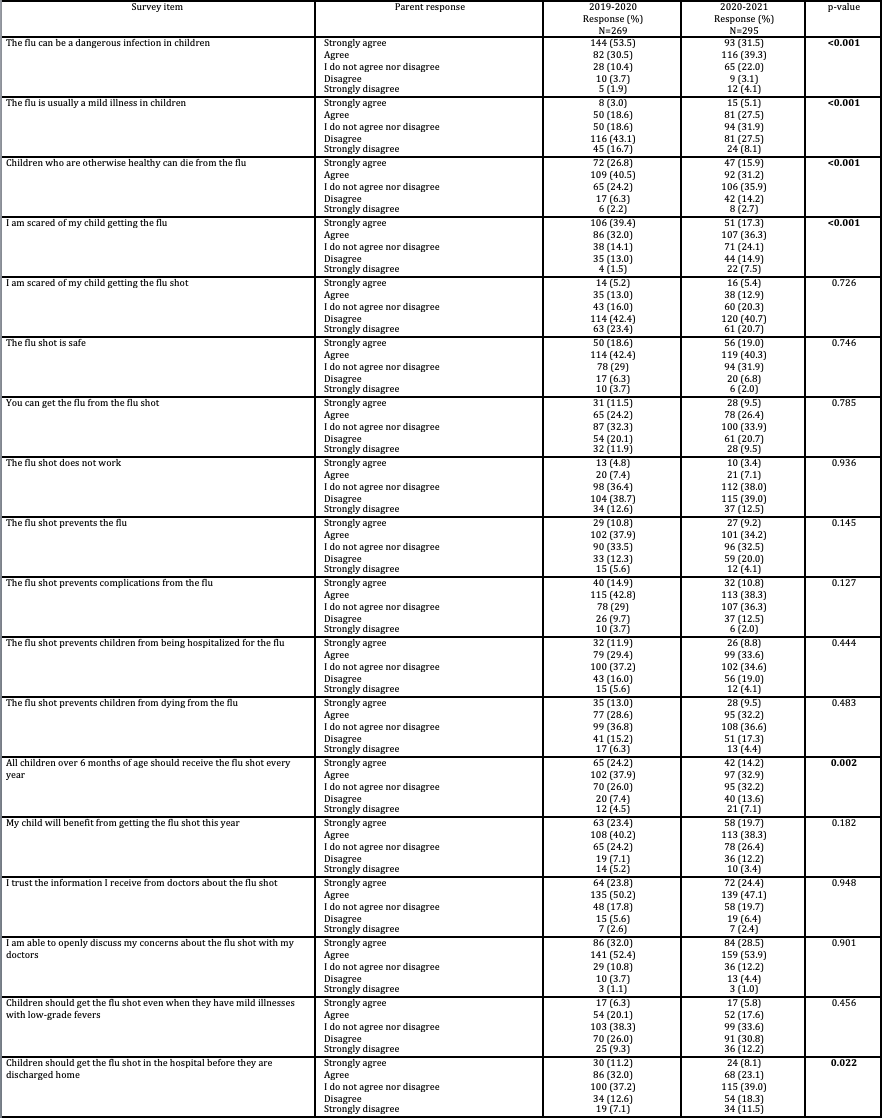Immunizations/Delivery
Category: Abstract Submission
Immunizations/Delivery I
507 - Influenza vaccine hesitancy in hospitalized children, before and during the COVID-19 pandemic
Sunday, April 24, 2022
3:30 PM - 6:00 PM US MT
Poster Number: 507
Publication Number: 507.325
Publication Number: 507.325
Marisa Orbea, Texas Children's Hospital, Houston, TX, United States; Jose Dominguez, Cambridge Health Alliance, Cambridge, MA, United States; Rachel Cunningham, Texas Children's Hospital, Houston, TX, United States; C. Mary Healy, Baylor College of Medicine, Houston, TX, United States; Julie A. Boom, Baylor College of Medicine, Houston, TX, United States; Claire E. Bocchini, Baylor College of Medicine and Texas Childrens Hospital, Houston, TX, United States
- MO
Marisa Orbea, MD (she/her/hers)
Fellow
Texas Children's Hospital
Houston, Texas, United States
Presenting Author(s)
Background:
Influenza vaccine is recommended for all children ≥6 months, yet uptake is suboptimal. Influenza vaccination coverage among children during the 2018-2019 season was lower than coverage for other childhood vaccinations. Influenza immunization in 2020-2021 also decreased by 5.1 percentage points from the 2019–2020 flu season.
Objective: We aimed to quantify child influenza vaccine coverage and identify factors associated with influenza vaccine hesitancy (VH) before and during the COVID-19 pandemic.
Design/Methods:
We conducted a prospective, repeated cross-sectional assessment in English and Spanish of caregiver influenza knowledge, attitudes, behaviors, and associated VH among hospitalized children 6 months through 18 years at a large pediatric medical institution. Caregivers were enrolled 4-5 days per week, between 12/11/2019--1/31/2020 and 12/8/2020--4/5/2021. VH was assessed using the Parent Attitudes about Childhood Vaccines (PACV) survey; PACV score ≥50 denoted VH. Descriptive statistics and multivariable logistic regression were used.
Results:
During 2019-2020 and 2020-2021 influenza seasons, 269/282 (95%) and 295/307 (96%) of approached caregivers enrolled, respectively. By caregiver report, 94% of children in 2019-2020 and 91% in 2020-2021 were up-to-date with routine childhood vaccines (p=0.13). Specific to influenza vaccine, 73% and 68% of children received or planned to receive influenza vaccine in 2019-2020 and 2020-2021, respectively (p=0.13). Based on PACV score, 13% of parents were VH in 2019-2020 compared to 17% in 2020-2021 (p=0.24; Figure 1).
Caregivers who had not/did not intend to vaccinate their children had a higher family income (71% vs. 57% >$30,000, p< 0.01) and were less likely to be Hispanic/Latino (35% vs. 47%, p=0.02). 77% of caregivers were satisfied with information about influenza vaccine received from healthcare providers. Overall, 36% believed “you can get the flu from the flu shot.” In 2020-2021, caregivers were less likely to believe that “flu can be a dangerous infection in children,” to be “scared of my child getting the flu” and to agree that “all children over 6 months of age should receive the flu shot every year”.
Conclusion(s): During the COVID-19 pandemic, caregivers of hospitalized children were less concerned about influenza than pre-pandemic and misinformation about influenza persisted. Increased efforts may be needed to educate caregivers about the importance of influenza immunization during the 2021-2022 season.
CVMarisa Orbea CV 2021.pdf
Table 1. Caregiver knowledge and attitudes about seasonal influenza vaccine, 2019-20 versus 2020-21
Caregiver knowledge and attitudes about seasonal influenza vaccine, 2019-20 versus 2020-21
Influenza vaccine is recommended for all children ≥6 months, yet uptake is suboptimal. Influenza vaccination coverage among children during the 2018-2019 season was lower than coverage for other childhood vaccinations. Influenza immunization in 2020-2021 also decreased by 5.1 percentage points from the 2019–2020 flu season.
Objective: We aimed to quantify child influenza vaccine coverage and identify factors associated with influenza vaccine hesitancy (VH) before and during the COVID-19 pandemic.
Design/Methods:
We conducted a prospective, repeated cross-sectional assessment in English and Spanish of caregiver influenza knowledge, attitudes, behaviors, and associated VH among hospitalized children 6 months through 18 years at a large pediatric medical institution. Caregivers were enrolled 4-5 days per week, between 12/11/2019--1/31/2020 and 12/8/2020--4/5/2021. VH was assessed using the Parent Attitudes about Childhood Vaccines (PACV) survey; PACV score ≥50 denoted VH. Descriptive statistics and multivariable logistic regression were used.
Results:
During 2019-2020 and 2020-2021 influenza seasons, 269/282 (95%) and 295/307 (96%) of approached caregivers enrolled, respectively. By caregiver report, 94% of children in 2019-2020 and 91% in 2020-2021 were up-to-date with routine childhood vaccines (p=0.13). Specific to influenza vaccine, 73% and 68% of children received or planned to receive influenza vaccine in 2019-2020 and 2020-2021, respectively (p=0.13). Based on PACV score, 13% of parents were VH in 2019-2020 compared to 17% in 2020-2021 (p=0.24; Figure 1).
Caregivers who had not/did not intend to vaccinate their children had a higher family income (71% vs. 57% >$30,000, p< 0.01) and were less likely to be Hispanic/Latino (35% vs. 47%, p=0.02). 77% of caregivers were satisfied with information about influenza vaccine received from healthcare providers. Overall, 36% believed “you can get the flu from the flu shot.” In 2020-2021, caregivers were less likely to believe that “flu can be a dangerous infection in children,” to be “scared of my child getting the flu” and to agree that “all children over 6 months of age should receive the flu shot every year”.
Conclusion(s): During the COVID-19 pandemic, caregivers of hospitalized children were less concerned about influenza than pre-pandemic and misinformation about influenza persisted. Increased efforts may be needed to educate caregivers about the importance of influenza immunization during the 2021-2022 season.
CVMarisa Orbea CV 2021.pdf
Table 1.
 Caregiver knowledge and attitudes about seasonal influenza vaccine, 2019-20 versus 2020-21
Caregiver knowledge and attitudes about seasonal influenza vaccine, 2019-20 versus 2020-21